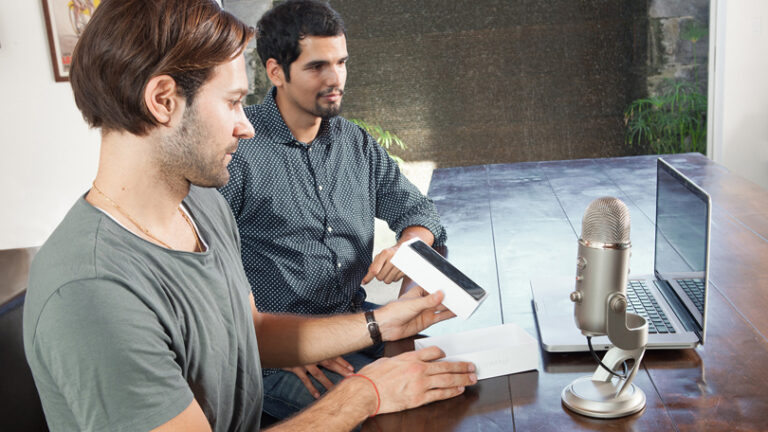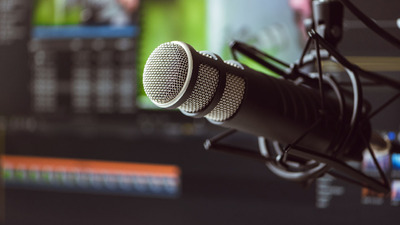
[ad_1]
Improving the quality of your podcast vocals isn’t rocket science, but it does require paying attention to some aspects of the recording process that you might be ignoring. After all, sound engineers and producers spend years honing their craft, and voice-over artists and radio personalities need to develop at least a modicum of mic technique. Understanding the basics of a microphone’s characteristics, be it a USB mic or an XLR mic, will help you approach your recordings with more confidence.
Understanding Microphone Polar Patterns
We’re not going to dive deep into the magic of how sound leaving your mouth is converted into accurate audio in your recording platform of choice. It’s thoroughly interesting if you like understanding the nitty-gritty of how things work, but for the purposes of this story, we’re going to focus on the first aspect of microphone operation that is crucial intel for anyone hoping to make a quality recording: polar patterns.
Simply put, a mic’s polar pattern refers to how its diaphragm accepts or rejects audio. For instance, does it reject audio that occurs off to the sides? Does it reject audio that occurs behind it? Many mics today feature more than one pattern—often employing multiple capsules inside one mic enclosure. But typically, XLR (and plenty of USB) mics have a fixed pattern. There are several patterns out there, but here we’ll focus on the most common options.
In diagrams, polarity is expressed in the form of a circle. A full circle represents the entire 360-degree field of possible sound, and the parts of the circle that are eliminated in the diagram represent areas in the surrounding audio field that the mic rejects or can’t pick up sound from very well. Obviously, this is a gradual measurement—the mic doesn’t cut off suddenly, it will typically fade in or out of an area where it picks up sound or rejects it, and so the resulting shape of a polar pattern will typically have rounded, bubble-like areas to represent these fades.
Cardioid
This is easily the most common pattern you’ll find. It looks a little bit like an upside-down, weirdly drawn heart shape. The valley between the two rounded parts of the heart shape represents an area that the mic rejects audio from—and since this area is at the bottom of the diagram, it refers to the space behind the mic capsule.
So a cardioid mic accepts audio primarily from dead-on, addressing the capsule by speaking directly into it. Move to the sides a bit, and the signal gets somewhat weaker. Move to the opposite end of the mic (as someone facing the person speaking into the mic’s front side would be), and the audio from that area will be primarily rejected. It’s gradual, of course—the capsule will pick up sound from this area, it just doesn’t pick up nearly as much.
Directly recorded audio will typically sound closer to the mic, and audio in the rejected areas of a mic’s signal, or near them, will sound different; from these areas, you’ll hear more reflections off of walls and other surfaces than direct signal into the capsule itself.
Cardioid is therefore ideal for recording a single speaker (or musician) and picking up a little bit less of the room’s reflections or any other audio behind the mic. Super and Hypercardioid patterns are more directional versions of cardioid patterns—they can offer somewhat better isolation for your sound source in a room crowded with other speakers, musicians, or sounds.
Figure Eight
Some mics can pick up roughly the same levels of direct audio when addressed from the front or back. Their diagrams look more or less like a figure eight. These mics are popular for a variety of applications, but two obvious choices are when you have two speakers or singers that you wish to have on the same channel or track when you mix. If two people are facing each other, like for an interview or a two-person podcast, a single figure eight mic properly placed between them can record the conversation onto a single mono track.
Figure eight mics are also useful for picking up a direct signal—a person singing or speaking—and its reflections in a space, such as the slight echo in a large room. In a room with high ceilings or highly reflective surfaces—that has been chosen for these characteristics—a figure eight mic can often capture a bit of that room’s magic along with the direct signal from the sound source, be it a person speaking or an acoustic guitar.
Omnidirectional
As the name implies, this pattern’s diagram looks more or less like a full circle—it can pick up audio in fairly equal measure whether it’s addressed from the front, back, or sides. The advantages here are many. Want to record the bustling sounds of a busy restaurant or subway station? Omnis are ideal for recording mono environmental sounds (don’t confuse them with stereo mics or stereo field recording devices, which use two closely placed capsules to get a true stereo representation of an environment that will record onto dual tracks). Or perhaps a roundtable discussion? If the table is literally round, and not too large, having each speaker within a foot or so of the mic could theoretically get a fairly even-sounding podcast onto one track.
However, the more speakers you’re recording, the more likely it is you’ll want a multi-mic setup to capture the audio. Since USB mics aren’t really made for multi-mic scenarios (most recording systems can only use one USB mic at a time), this is a way to record multiple speakers via USB. It may not be ideal, but it’s your best typical mic pattern for a single mic scenario if you have a group of people talking. The challenge, of course, will be getting each person to match the other’s levels so that certain speakers don’t stand out while others seem faint. And that brings us to mic technique.
Mic Technique
Just as stage acting requires a particular style of vocal projection compared with acting on camera, speaking into a microphone requires techniques that will differ more radically than you might guess from speaking in your daily life. To understand why this is, let’s discuss some of the most obvious factors that can impact a vocal recording.
Plosives
P sounds, along with F sounds and a variety of other consonant combinations, create a varying degree of air movement. The less experience a speaker is, the more their plosives will likely send an unwelcome breeze through the microphone. This can often cause distortion in a recording, but even if it doesn’t, it almost never sounds good.
How do you prevent plosives from ruining recordings? Well, even pros will let some pops fly into the mic once in a while, but the two keys to eliminating plosives are pop filters and better mic technique.
A pop filter clips on to a mic stand and places a thin layer of usually nylon or perforated metal (through which sound passes easily) between the speaker and the mic. Ideally, when a plosive hits the filter, the gust of air is dispersed relatively silently and doesn’t reach the mic itself, but the vocal sound—the word with the P or F—still does. In other words, it takes a plosive and makes it a far more palatable sound.
But filters can’t do it alone—mic technique is indispensable for plosives. I recorded professional voice-over actors in my former career, and was amazed to see some of these skilled speakers refuse to use a pop filter. They didn’t want the barrier between them and the mic—and so they honed their mic technique to the point that it was unnecessary. Mere mortals (likely most of the people you will record) are not advised to go sans pop filter, but by subtly angling your mouth away from the diaphragm on plosive sounds, you can avoid much of the issues for which pop filters were created. It’s also about limiting lip movement on plosives, and it takes lots of practice to get a natural sound while doing this. But everyone can try a little bit and hear some results. Combining mic technique like this with a pop filter? That’s a solid combo.
Sibilance
Pop filters will help less with sibilance, which is usually the result of too much EQ in the high-mids and highs. Too little sibilance in a recording is going to make it far less intelligible for the listener—you need a certain degree of it to understand language.
A pure signal from a mic worth its weight won’t add much sibilance to the equation and, generally speaking, most people aren’t going to be overly sibilant on their own. There are exceptions, of course, but if things sound too “ess”-heavy, try adjusting the EQ between 4kHz-8kHz. Sibilance is most often going to be in that range, but it can vary. You want to zero in on a narrow range of frequencies here and then lower the levels a bit, which typically means using a peak-style EQ and not a shelf-style EQ (which will raise or lower every frequency above or below it, depending on what type of shelf it is). You can usually see which type you’re using in any decent EQ plug-in.
Unless the sibilance is impossible to tolerate, it’s probably best to make EQ adjustments after you record so you have more flexibility.
Proximity Effect
This mic technique comes into play particularly for speakers who have deep, baritone voices (though it’s true for all voices). The closer a speaker (or any sound, really) is to the mic, the louder the lower, bass-like frequencies in that speaker’s voice will sound in the recording. The difference between being eight inches away from the mic and four inches away will be pretty dramatic. Not only will it be a louder recording in general, but the bass levels on the closer vocals will sound more intense. Perhaps that sounds like a good thing, but it rarely is for vocals, unless you’re going for a deep-voice effect.
Typically, someone with a deep voice needs no extra help from the mic to sound like they do—what they need is the clarity the mic’s crisp response can provide, and adding bass to the equation often makes things sound boomy or muddy. If your recording subject is sounding too bass-heavy or rich in the lows, tell them to move their head back a few inches, or take a small step backward from the mic, and play with distances between the speaker’s mouth and the mic’s capsule until those low frequencies are tamed.
Recording Environment
This one is pretty obvious, but where you record is going to have a huge impact on the recording—and I’m not just talking about whether you hear car horns in the background. A room with lots of glass or tiled surfaces is going to have a very live, echo-like sound to it, like most bathrooms or stairwells. A room covered floor-to-ceiling in carpet and sound-absorption materials will have a dead sound, and although this may be advantageous, the most natural sound will likely be somewhere in between, leaning toward the dead-sounding end of the spectrum.
You can record in a live-sounding, reflective room without the speaker sounding like they’re in an echo chamber—try surrounding the speaker with non-reflective materials, and get creative. Recording studios with large live rooms might use shields covered in cloth, called gobos, to isolate instruments in the same room, and it works to a large extent. Not only does it block out some outside surrounding sounds, but it can cut down on reflections, too. You can make your own gobo, or you can drape some quilts over whatever is the proper height, or move the speaker near a set of curtains. Some people record in a closet full of coats.
Recommended by Our Editors


Experiment, with this in mind: Hard, shiny, or polished surfaces are often the most reflective (tile, glass, some metals) and soft, cloth-like surfaces tend to absorb reflections (pillows, blankets, curtains, foam, you get the idea). Wooden surfaces fall somewhere in between (depending on the finish and type of wood), and can be desirable for creating a natural sound when combined with some sound-absorbing materials nearby.
Gain Levels
Hopefully this is a no-brainer, but you need to get levels on your subject before you start to record. Ask the speaker to give you their realistic loudest voice, and with the gain knobs or fader at a very low level, slowly raise the level until the speaker’s voice is regularly keeping the meters in the middle, without going into the red area much, if at all—the red area indicates dangerous peaks, which cause can distortion.
One rule of thumb for recording less-experienced vocalists: Almost no one will give you their loudest level when you ask them to, because they will self-consciously limit themselves a bit. So it’s always safer to assume the loud levels you’re getting are roughly 80 percent of what your subject will actually belt into the mic when singing, laughing, or yelling without thinking about it. In other words: Record at lower levels to avoid distortion. You can always run particularly dynamic or unruly vocals through a dynamic compressor afterward—plenty of engineers apply a little compression while recording.
EQ and Compression
EQ and compression are best used after recording until you understand fully how they work, which could be an entire textbook on its own, so we’re not going into wild detail here. Keep in mind, however, unless you’re going for a specific sound effect, your use of both EQ and compression should be quite subtle—boosting the high-mids heavily or squashing the peaks with a high compression ratio will result in amateur-sounding recordings.
For your podcast, you’re presumably going for a natural sound that is fairly transparent and clean. If your mic is lacking in high-mids, by all means boost them a decibel or three. If it’s sounding muddy, you can also try cutting some low-mid or low frequencies a bit. If sibilance is an issue, try what’s discussed in the section above. For compression, try to avoid going beyond a ratio of 4:1, though this will depend on so many factors, it’s hardly a rule of thumb. It’s also worth pointing out that, if mic placement and vocal talent align, some recordings will sound so good that compression and EQ are not necessary. And it is definitely worth mentioning that plenty of USB mics already add in a little bit of both if they are employing DSP (digital signal processing). Each mic is different, so make sure to understand yours before you paste compression onto a recording that already has a healthy dose of it.
Use the Right Mic
If you’re in the market for a microphone, you probably know exactly what you want to use it for. But it’s important to realize that a high-end mic geared toward musicians might actually offer far more fidelity (and way less convenience) than you need to record a podcast.
We’ve tested plenty of USB microphones and accessories to determine which ones are the best for podcasting, among other scenarios (as well as different budgets). Check out our guide to the best USB microphones for a deep dive into picking the right model for you.
Trust Your Ears
The most crucial thing is to actually listen to what you are recording—through headphones and also on speakers, if possible. When we’re learning something new, it can be overwhelming, and we might let some things slide that we wouldn’t necessarily accept as listeners checking out someone else’s recordings. When the speaker raises their voice or laughs, does the audio distort? Is someone moving around too much, so that sometimes they sound very close and other times far away? Are you getting annoying sounds of clothing rustling or plastic water bottles being set down? Are plosives making every word with a P sound like a miniature explosion?
It’s a good idea to model your sound, at least at first, after a podcast you think is recorded very well. You may not have a pro-level studio and multi-mic setup, but even those scenarios all still require basic mic technique and placement, and getting the right levels. Your goal should be to get the mic placement set to a spot that will give you audio that needs little or no EQ, and little or no compression—the more experienced the person you’re recording is, the easier this will be. But even if you’re recording someone who hasn’t been in front of a mic before, it’s your job to coach them—try to do this at the source by communicating with the speaker, rather than trying to “fix it in the mix,” as the old industry saying goes.
The bottom line is: Don’t overthink it, and trust your instincts—when something stands out to you as bad, address it. When things are sounding good, take note of where the speaker’s mouth is in relation to the mic, and your gain levels. Really listen to what you’re recording, and follow your ears—your recordings will need less help in the mixing process when you focus on getting the best sound through the mic at the outset.
[ad_2]
Source link : https://www.pcmag.com/how-to/how-to-make-your-podcast-sound-better



